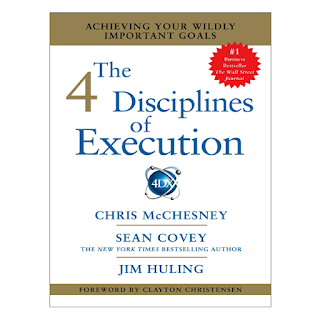The 4 Disciplines Of Execution Summary
Tag Line: The 4 Disciplines Of Execution outlines the path that company leaders and individuals must follow to set the right goals and improve behavior to achieve success on a bigger, long-term scale.
Most of us determine at the end of December that we’ll be in the gym every week come January. Next thing we know, it’s March and we haven’t met our workout goal for a month.
Why is it so hard for us to stick to our goals? We find the answer by looking at the way we execute, which is where most of us fail. Whether you’re a business or an individual, you’ve got to execute well if you want to change.
So what does it take to do it right? That’s what The 4 Disciplines of Execution will teach you just how to do. It will help you clarify the most important goals, set measures for success, stay inspired by keeping track correctly, and stay consistent with accountability.
Here are the 3 of the most helpful lessons from this one:
1. Only focus on the most important goals that will have the biggest impact.
2. Set up the right tracking system to keep score and stay motivated.
3. Increase commitment to your goals by implementing accountability measures.
Ready to discover some exciting new methods that will transform your goals and your life? Let’s dive right in!
Lesson 1: Focus on the essentials, only those things that will have the most impact, when setting goals.
Which would you rather have, a lot of peaches that are just okay, or a few of the most giant, juicy, and sweet peaches you’ve ever had?
If you’ve ever had a mediocre peach, you’ll likely know the latter option is far better. But you can’t have the best peaches if you try to make all of them good. That’s why you have to thin the tree so that it focuses on growing only a few to be the best.
Your goals are just the same way. When you set too many, you run out of energy to put into all of them and end up succeeding at none. That’s why you need to prioritize just a single Wildly Important Goal, or WIG.
To find these you have to think and ask yourself the right questions to find out what makes the most difference. A company executive might do this and set the WIG of cutting costs by 20% before the end of the year. As a rule, make them specific and focus only on what has the biggest impact on success.
If you can find a goal to set that will knock down many others you have, that’s a great place to start.
NASA’s experience putting the first man on the moon is a perfect example of how powerful being specific is. Prior to President Kennedy’s declaration in 1961 that they would get to the moon by the end of the decade, the organization wasn’t very specific.
Their initial ambiguous goal was to expand “human knowledge of phenomena in the atmosphere and in space.” Once Kennedy helped them get specific, their success took off, literally!
Lesson 2: You’re more likely to stay motivated toward achieving your goal if you set up your tracking system correctly and keep score.
So the first discipline focuses on what your goals should be. Disciplines two and three describe how you should keep score of your goals in a way that leads to success.
To understand how to do this, you’ve got to know the difference between lead and lag measures, which is discipline two. A lag measure is what happens after you put in the work. One example is losing weight. If you only focus on these, however, you’ll end up depressed.
That’s why you need to identify the lead measures, or actions that will get you to achieve your lag measures. For our losing weight example, eating healthy and exercising three times a week are good examples of lead measures.
Discipline three involves keeping score to help yourself, or your team if you’re a business, remain motivated. Think of kids playing a soccer game. Without keeping score there’s not a lot of motivation for them to work hard and get goals!
Your scoreboard should be comprehensive, including the WIG and lead and lag measures. It should identify where you are and where you need to be at each step.
Your business might set a WIG to boost production by 20% before the end of the year. If it’s already the end of August, you have four months left so you’d need to increase production by 5% each month to meet your goal. You would put this on your scoreboard and the appropriate lead and lag measures that go with it.
Lesson 3: Accountability is the holy grail of following-through with goals.
This last discipline is a powerful one that is at the core of improving the execution process. It’s also the best way to help yourself or your team commit to long-term goals.
When you’re accountable, you review your actions and declare what you accomplished or didn’t. When your team or yourself as an individual become accountable to others, your chances for success skyrocket.
This is because your sense of responsibility rises when you know that you’re going to have to answer for what you have or haven’t done.
To stay accountable, have weekly WIG meetings. In these, you’ll want to make sure you include the following steps:
1. Review what you committed to do last week and how it went.
2. Update and analyze the results of the scoreboard.
3. Make your plan for the week ahead based on where you’re at and where you need to be.
By looking over your weekly growth, you ensure steady progress toward your goal. Without these meetings, you’re left wandering without really knowing where you’re at.
This means you’ll never know what you need to do to meet your goal in the timeline you’ve set for yourself, which is a recipe for disaster. In this way, a weekly review is a perfect habit to get into if you want to make achieving your goals inevitable!
Final Words
I really liked The 4 Disciplines Of Execution and I believe you will too. Although it’s geared toward companies, there are a lot of useful tips for achieving goals as an individual. I’m confident that if you read this book and apply what it teaches, your goal-setting methods will improve and as a result, you will too!








